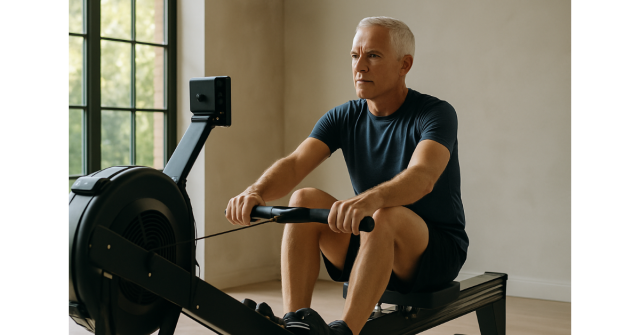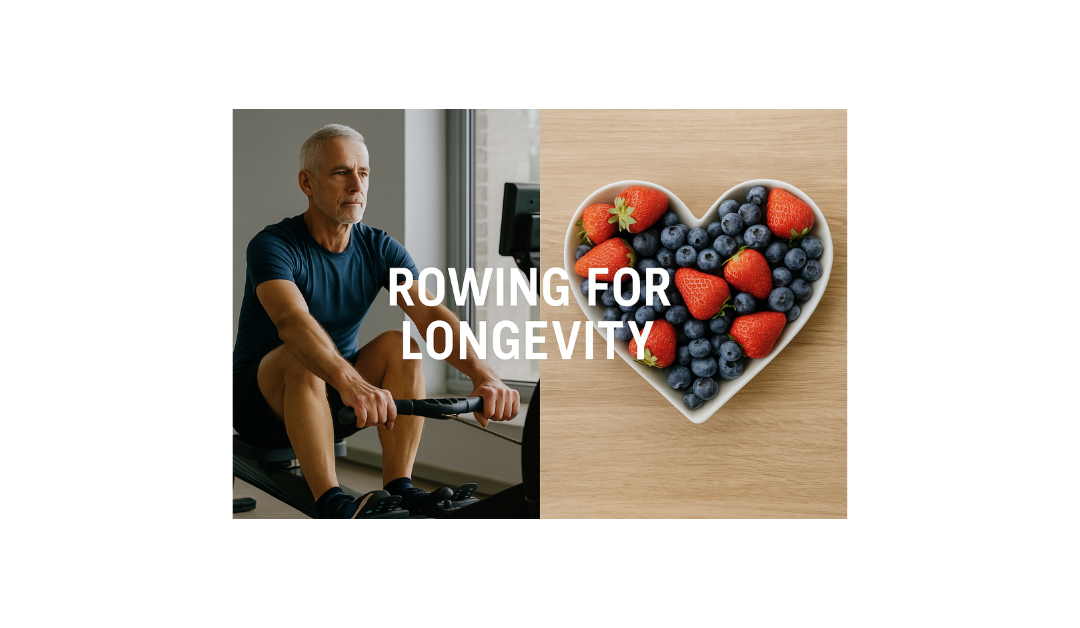Indoor rowing can be a cornerstone of long-term health—if you balance training intensity, strength work, recovery, and lifestyle. This guide explains Zone 2 vs Zone 5, why to limit long Zone 3/4 grinds, and how sleep, nutrition, mobility, and alcohol moderation protect your heart and performance—using clear, readable science.
Why Longevity Training Matters in Rowing
Rowing taxes the heart and repeats the same powerful hip-hinge thousands of times per week. Without smart intensity distribution, you invite chronic fatigue, overuse injuries, and—over many years—higher risk of atrial fibrillation (AF), an irregular heart rhythm seen more often in veteran endurance athletes.
Bottom line: Balance stimulus and recovery. Train for decades, not just the next 2K.

The indoor rowing machine should promote health and longevity.
Zone 2: The Longevity Sweet Spot
What it feels like: Conversational pace; ~60–70% max HR; steady breathing. On the erg, think comfortable, sustainable power.
- Builds mitochondrial density (more efficient energy production).
- Improves fat metabolism, sparing glycogen and reducing stress.
- Strengthens the cardiovascular system without excessive wear-and-tear.
Programming: Make Zone 2 at least 80% of your weekly volume.
Zone 5: Short, Sharp, Powerful
What it feels like: Very hard, VO₂ max efforts; can’t speak in full sentences; short intervals with full recoveries.
- Boosts VO₂ max (a strong predictor of longevity).
- Maintains fast-twitch fibres and top-end power as we age.
Programming: Once weekly is plenty. Example: 8 × 2 minute hard, 2–3 minutes easy between; full quality, no junk volume.
Why to Limit Long Zone 3/4 Work
Moderate-to-hard “always pushing” rows feel productive but often create the most cumulative cardiac and hormonal stress. Over years, that stress may remodel the atria and elevate AF risk.
Use it sparingly for race prep and thresholds; don’t live here week-in, week-out.

Slumped in exhaustion on a Concept2 rowing machine, illustrating the risks of overtraining and too much Zone 3/4 intensity.
Strength Training for Lifelong Rowers
- Preserves muscle and bone (critical after 40).
- Improves stroke power and efficiency.
- Protects against overuse injuries.
Programming: 2–3 sessions/week. Prioritise compound lifts (hinge, squat, push, pull), plus trunk stability. Keep reps in moderate ranges, move well, and progress gradually.

Deadlift, demonstrating the importance of strength training for rowing longevity and health.
Mobility, Stretching & Yoga
Counter rowing’s repetitive posture with daily mobility:
- Hip openers, hamstring flexibility, thoracic rotations.
- Short post-row stretch (10–20 minutes).
- Yoga or Pilates for breathing control, balance, and stress reduction.
Recovery: Sleep, Rest Days, Stress
- Sleep: 7–9 hours supports heart recovery, hormones, and immune health.
- Rest days: 1–2 per week. Include easy walking or gentle mobility.
- Stress balance: Life load + training load = total load. Use breathwork or mindfulness to keep the system calm.
Nutrition & Alcohol: Heart-Smart Choices
- Whole-food emphasis: plants, lean protein, whole grains.
- Protein: ~1.6–2.0 g/kg bodyweight/day to maintain muscle.
- Omega-3s: oily fish, flax, chia—support anti-inflammatory balance.
- Hydration: keeps cardiovascular strain down and performance up.
- Alcohol: Keep it minimal; even moderate intake increases AF risk in endurance athletes.

Fresh blueberries and strawberries, highlighting the role of nutrition in supporting cardiovascular health and rowing longevity.
A Longevity-Focused Weekly Template
- 3 × Zone 2 (45–75 minutes steady rowing)
- 1 × Zone 5 (short intervals; high quality)
- 2 × Strength (full-body)
- Daily mobility/stretch (10–20 minutes)
- 1–2 rest days (active or full rest)
Adjust volume to your age, history, and recovery—consistency beats hero weeks.
FAQs
Is Zone 3/4 “bad” for me?
No—just limit long bouts week after week. Use it intentionally for threshold development and race phases; otherwise, build mostly in Zone 2 with brief Zone 5.
How much alcohol is “safe” if I row?
There’s no universal safe dose for AF risk. For longevity and rhythm stability, the most protective approach is minimal intake (or none), especially around key training days.
Can rowing cause atrial fibrillation?
Rowing itself is heart-healthy. The concern is chronic, high cumulative load (years of long, hard training with limited recovery). Smart zone distribution, rest, and lifestyle practices reduce that risk.
How do I find my training zones?
Use a recent 2K or a field test to estimate thresholds, or a lab test if available. Practically: Zone 2 feels conversational; Zone 5 is very hard and only sustainable in short bursts.
How many rest days do I need?
Generally 1–2 per week. If life stress or poor sleep is high, add recovery before intensity resumes.
References (key studies)
- Holloszy JO. (1967). Biochemical adaptations in muscle. J Biol Chem.
- Eijsvogels TMH et al. (2016). Exercise at the extremes. J Am Coll Cardiol.
- Kodama S et al. (2009). Cardiorespiratory fitness & mortality. JAMA.
- Mont L et al. (2009). Endurance sport & AF risk. Europace.
- Andersen K et al. (2013). Arrhythmias in endurance athletes. Eur Heart J.
- Mitchell WK et al. (2012). Sarcopenia with aging. J Cachexia Sarcopenia Muscle.
- Cramer H et al. (2014). Yoga & cardiovascular disease. Eur J Prev Cardiol.
- Qureshi W et al. (2015). Sleep quality & AF. J Am Heart Assoc.
- Morton RW et al. (2018). Protein for older adults. Br J Sports Med.
- Mozaffarian D et al. (2005). Fish intake & AF risk. Circulation.
- Voskoboinik A et al. (2018). Alcohol & AF. J Am Coll Cardiol.

